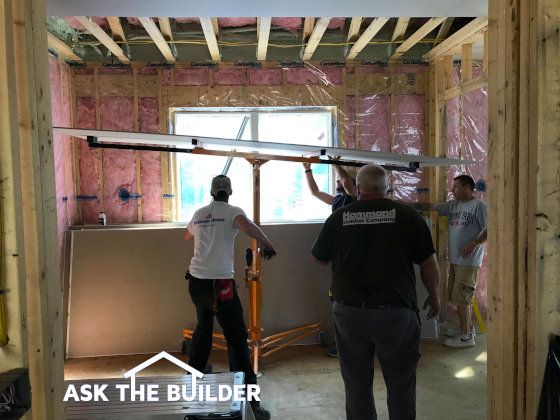Drywall Requires Muscle and House-Cracking Noises

Large sheets of drywall are very heavy. You can rent machines that hold the sheets up against the ceiling. (C) Copyright 2019 Tim Carter
Drywall Requires Muscle
QUESTION #1: Tim, I need your honest advice. I’m seriously pondering installing new drywall in a room addition while I’m on vacation. I’ve watched cable TV shows, numerous online videos and read a few articles. It really doesn’t appear to be that hard. I’ve got a few helpers so I’m convinced we can install the material and finish it. Is drywall work harder than it looks? What are a few tips you can offer to help me complete this with a minimal amount of work and frustration? Mike M., Tyler, TX
Have you been on the receiving end of some of the digital courage that fueling Mike’s positive attitude? It’s easy to get intoxicated by what you see on shows and such. All too often the producers tend to gloss over the hard stuff. After all, if you walked away from a few TV shows thinking everything was too hard to do, you’d probably stop watching. I can tell you that’s the last thing the cable TV channel and producers want you to do!
It’s important to realize lots of books have been written about the craft of drywall installation and finishing. One of the best is the Gypsum Construction Handbook published by one of the top manufacturers of the drywall and finishing compounds - USG Corporation. I highly recommend reading the chapters about drywall so you make sure you’re installing it correctly.
Another key point is the weight of the material. You can now purchase drywall or sheetrock that weighs less than its predecessors, but even the lightweight material’s weight might stun you. Lifting and hold a 4x12 sheet of 1/2-inch drywall over your head while trying to monkey around with the screws and screw gun might extract all the strength and skill you have. I guarantee you’ll be sore the second day.
Installing drywall can be nasty dusty work. Razor knives are used to score, snap and cut the large sheets. Professionals use handy small hand-held routers with special bits to make the cutouts for electrical boxes and other fixtures. You might use a traditional punch saw made for drywall. By all means, do not use a circular saw to cut drywall like you might plywood or OSB!
Be sure you use the correct length screw and recess it just enough so it doesn’t tear the paper facing. Screw guns have precision depth adjustments so you get the screws just right. On ceilings, place the screws on 12-inch centers. On walls, the screws can be 16 inches on center.
Finishing drywall is an art. It requires significant hand-eye coordination. You need to mix the finishing compound so it’s the correct consistency. I prefer to have mine like moist mashed potatoes or warm cake icing. Put too much compound under the tape and you’ll have humps in your walls. Put too little under the tape and you’ll end up with blisters when you second coat.
I recommend that you build a test wall and practice finishing it before you ruin your new room addition. You’ll be stunned how hard it is to get professional finishing results if you’ve never done it before.
How do I feel about drywall finishing? Read about it in the August 4, 2009 Newsletter.
House-Cracking Noises
QUESTION #2: Hey Tim, it’s been really hot here the past few weeks. In the evening while watching TV with my husband, all of a sudden our deck and our house makes a cracking or popping noise. Sometimes I hear it up in the roof, but it’s often a noise in a wall. I’m worried that our house is going to fall apart and collapse. What’s causing the cracking and popping and should I be concerned? Elizabeth B., Knoxville, TN
Elizabeth would hear the same sound if she came to my own home. She’s hearing the lumber and decking moving as they cool down from the extreme temperature swings that happen on brilliant sunny days.
The sun can and does heat up roofs and walls. Here at my own home, my roof temperature gets close to 160 F. The wall siding is just a little below that and my composite decking gets so hot you can’t walk on it with bare feet. Composite decking that’s got lots of plastic in it expands quite a bit when heated.
This heat is transferred to the framing lumber in the roof, exterior walls, and deck structure. If you pay attention in the late morning, you might also hear cracking and popping as the lumber is expanding.
When the sun is setting the house material starts to cool down and it contracts. This movement can create a cracking sound much like when you crack a knuckle or an ankle tendon. It’s normal and not a reason for concern.
I’d only start to be concerned if I saw cracks in the interior finishes that started growing in size. If you are extremely concerned, you can hire a residential structural engineer to inspect your home and confirm all is well.